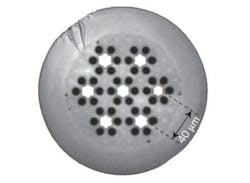(Image: CREOL)
An international team of researchers has combined a seven-core few-mode optical fiber with compact 3D waveguide multiplexers and frequency-domain multiple-input multiple-output equalization to transmit 255 Tbit/s of data over a 1 km fiber span; this data rate allows 21 times more bandwidth than is currently available in fiber-optic communication networks.1 The system uses 50 wavelength carriers on a 50 GHz grid.
The team has members from Eindhoven University of Technology (TU/e; Eindhoven, The Netherlands), the College of Optics and Photonics (CREOL) at the University of Central Florida (Orlando, FL), and Tianjin University (Tianjin, China).
To transmit more information through conventional single-core optical fibers, one option is to increase the power of the signals to overcome the losses inherent in the glass from which the fiber is manufactured. However, this produces unwanted nonlinear photonic effects, which limit the amount of information that can be recovered after transmission over the standard fiber.
Few-moded data-rate boost
In addition to seven cores, the new optical fiber introduces two other orthogonal dimensions for data transportation via different fiber modes (the "few-mode" characteristic). The fiber has a data rate of 5.1 Tbit/s per carrier per wavelength per core; the few-modedness is what allows for 255 Tbit/s transmission.
The team is led by Chigo Okonkwo, an assistant professor in the Electro-Optical Communications (ECO) research group at TU/e, and Rodrigo Amezcua Correa, a research assistant professor in microstructured fibers at CREOL.
"At less than 200 microns in diameter, this fiber does not take noticeably more space than conventional fibers already deployed," says Okonkwo. "These remarkable results, supported by the European Union Framework 7, MODEGAP, definitely give the possibility to achieve petabit-per-second transmission, which is the focus of the European Commission in the coming 7 year Horizon 2020 research program."
Sources:
2. http://www.creol.ucf.edu/NewsEvents/NewsDetail.aspx?NewsID=550
REFERENCE:
1. R.G.H. van Uden et al., Nature Photonics (online, 26 October 2014); doi: 10.1038/nphoton.2014.243
